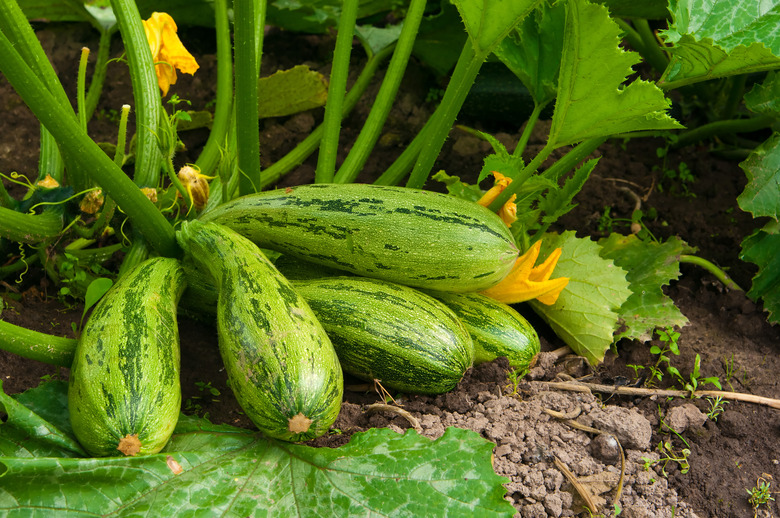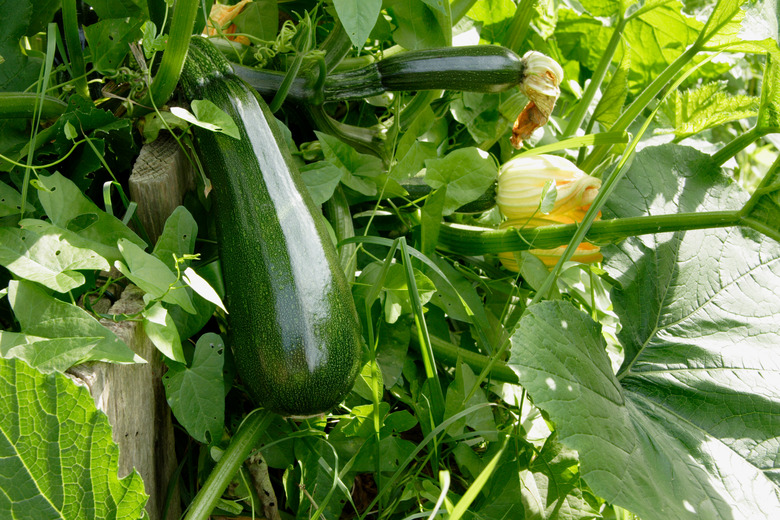How To Grow Zucchini Squash
If you are looking to plant something in your vegetable garden this summer that's versatile, very prolific, and easy to grow, zucchini squash (Cucurbita pepo) may be the vegetable for you. Zucchini squash is an annual warm-season crop that grows on bushy, non-vining plants. The fruit from a zucchini plant is usually cylinder-shaped, and the outside skin, which is edible, most commonly has a green color, although it can also range from yellowish to nearly black in color. It can also have light-colored freckles or stripes.
These summer squash have large, broad leaves and are very bountiful, with an average of four to six stems growing from the root of each plant.
Zucchini squash are frost-sensitive, warm-season annual plants that do well with warm temperatures and sunlight. Both male and female flowers are produced and grow separately on the same plant, with the male flowers appearing first. Male flowers pollinate the female flowers with the help of bees and other insects but can be hand-pollinated if needed. Fertilizing occasionally will improve growth, and keeping mulch around your zucchini plants will protect the roots and prevent weeds. The plants should be watered deeply once a week with enough water that the moisture reaches a depth of 4 inches into the soil.
Best Uses for Zucchini Squash
Because a healthy plant can produce multiple zucchini fruits each day at its peak, you may end up with a larger crop than you know what to do with, especially if you have more than one zucchini plant. This shouldn't be a problem, however, because there are many different ways to use it. Like most fruits and vegetables, zucchini squash tastes best when it is fresh, but it can also be stored in the refrigerator for up to two weeks after being harvested.
Along with its great taste and tender texture, zucchini is quite healthy and a good source of beta-carotene and vitamins C and E along with several important minerals. This makes it a healthy addition to many dishes, including salads and pasta. Zucchini bread and muffins are very popular, and it is often added to sauces and stews. Because most gardeners often end up with an overabundance of zucchini, it is frequently chopped up and used to make relish that can be used on everything from burgers to sandwiches. Zucchini relish can be jarred and stored for use throughout the winter until the end of the next growing season, when you can make more.
If you end up with more zucchini than you know what to do with, it can be frozen for use at a later date by shredding the unpeeled zucchini and then straining it. After straining the shredded slices, pat them down with a paper towel to get rid of any excess moisture. Then, place it in sealed freezer bags for later use. Frozen zucchini should be used within approximately three months.
Starting Zucchini Squash From Seed
Zucchini sprouts and grows so quickly that it usually isn't necessary to start your seeds indoors. However, if you would like to get a head start on it, you can start the seeds indoors or in a greenhouse two to four weeks before the final spring frost. Use peat pots, which can be transplanted directly into the ground when the soil is warm enough without disturbing the roots. If possible, choose a location with full sun, well-draining soil, and low wind to help with pollination. Work some garden compost into the soil before planting.
To direct-seed zucchini in the garden, place the seeds into 1-inch-deep holes using only two seeds per hole. Zucchini plants are bushy and have large leaves when developed, so the plants should be spaced 3 feet apart, measured from the centers, although in areas with limited space, this can be reduced to 1 1/2 to 2 feet. Because most packaged zucchini seeds stay viable for up to four years if stored in a cool, dark place, and it takes so few seeds to grow zucchini, you can use a package's remaining seeds during the next few years.
An alternative planting strategy that can work better in colder northern climates is to sow your zucchini seeds on a small mound, which allows the raised soil to stay warmer. After sowing the seeds in either 1-inch holes or mounds, cover the holes with soil, firm the soil lightly and cover them with a layer of garden compost or other organic mulch to help maintain a consistent, even soil-moisture level, which is very important for the health of these plants. Water the area well after the seeds are planted.
Starting Zucchini Squash From a Seedling
Because they grow so easily and prolifically from seeds, many gardeners grow their zucchini from seeds. If you'd prefer to get a head start, however, you can purchase and plant seedlings. Transplant shock is often a risk with zucchini squash, so try to purchase them in peat pots or other compostable material that can be set directly into the ground without damage to the roots.
As with seeds of other types of plants, you should work some organic garden compost into the soil before planting young plants. The best seedlings have four to six broad, healthy leaves and are as wide or wider than tall. When transplanting, the stem should be buried up to the first leaf, so be sure the hole is deep enough for this. Then, refill the hole and pat it firmly around the stem. Like seeds, a seedling should be watered very well after planting.
If a seedling is planted later in the season, try to shade it in the middle of the day to protect it from the sun. The root system of zucchini squash can reach up to 4 feet, but most of the roots reach 12 to 18 inches, so keeping the moisture level even is important. Too little moisture can cause small or misshapen fruit, while too much can result in root damage as well as blackened or bitter-tasting fruit.
In What Zone Does Zucchini Squash Grow Best?
A zucchini squash plant not only produces a large harvest but it can be grown as an annual in USDA hardiness zones 3 through 11, meaning it can be grown in most places in the United States, from the desert conditions of Arizona to the most northeastern state of Maine. As long as the ground temperature is above 60 degrees Fahrenheit, your zucchini plants will grow.
Other factors needed for optimal growth include air temperatures over 70 degrees and daily sunlight of six to 10 hours. Along with full sunlight, zucchini is best when planted with shelter from the wind because this allows for good pollination.
When Should You Plant Zucchini Squash?
Plant your zucchini squash two to three weeks after the final frost of the season, when the soil temperature reaches a consistent temperature of at least 60 degrees at a depth of 2 inches. Frost will kill a zucchini plant, so by planting later, you will not only avoid frost issues but also pests and diseases that are common in the early season. The date that you should sow your zucchini seeds will differ based on your region.
Soil, Sunlight, and Water Recommendations for Zucchini Squash
Zucchini squash needs full sun, requiring six to 10 hours of daily sunlight for optimal growth and development. It does best with well-draining soil because, though it likes moist soil, a zucchini plant will fare poorly if the soil is too wet or too dry. Soil should never get to the point of being soggy or too dry. Well-draining soil will keep the moisture levels the way a zucchini squash plant likes it.
Zucchini plants require regular, steady watering, and you should water zucchini plants deeply once a week when it's cool. They need a lot of water as the temperature rises, so in the midsummer heat, increase the deep watering to two to three times a week. With a deep watering, the soil will be moist at least 4 inches down. When watering by hand, try to water at the base of the plant and avoid watering the leaves to prevent mildew and other fungal diseases.
A soil pH range of 6.0 to 7.5 is best, and soil that is rich with compost and nutrients will help zucchini plants to grow, so much so that additional fertilizer may not be needed. If the soil is not so rich with nutrients, which a soil test will reveal, an organic fertilizer can be applied every two to three weeks. Fertilizers high in nitrogen will only result in more leaves and stems with fewer fruits and should be avoided.
How to Winterize Zucchini Squash
As a warm-weather annual that needs a lot of sun and warmth, zucchini plants can't be grown in cold or cool weather. They can, however, be grown inside during the winter in a container. Compact zucchini hybrids such as 'Gold Rush' and 'Classic' are good choices for growing inside. Because zucchini plants need a lot of sun, indoor potted zucchini will grow best if the pots are located in a south-facing window where they are most likely to get five to six hours of sunlight each day.
How to Harvest Zucchini Squash
You don't need to wait for a certain date or time to harvest zucchini. It can be harvested when it reaches the right size. It will usually mature within 60 days of planting. Picking zucchini when it reaches 6 to 8 inches in length will result in a tender, excellent-tasting fruit. Allowing the fruit to grow larger will result in a tougher fruit with an inferior, sometimes bitter, taste.
Zucchini fruit grows very quickly, so don't wait an extra day or two to pick them because you may end up with fruit the size and texture of a bowling pin. Once it begins to ripen, a zucchini plant should be picked every day or every other day. Cut the fruit from the stem with a sharp knife, leaving an inch or so of stem on the fruit because you run the risk of damaging the entire plant by trying to pull it off.
Common Pests and Other Problems for Zucchini Squash
Pests can take a toll on your zucchini crop. Some common pests that can damage your plants often appear early in the season. Squash bugs, whiteflies, and spider mites can be brushed or scraped off the plant. Brushing them into a bucket of water will keep them from reappearing, or you can spray them from leaves with diluted insecticidal soap.
Squash vine borers are common pests that bore into stems and cause them to rot. They are most active in the summer. The stems can be protected by wrapping them in foil. These pests can also be cut out by cutting vertically into the stem, but you'll want to be careful not to damage the stem when doing this.
Common Diseases for Zucchini Squash
Mildew is a common zucchini plant disease. It can leave a white coating on the leaves and is usually caused by poor air circulation — plants being too close together — and improper watering. Along with watering correctly and leaving adequate space between plants, you should remove the affected leaves. Look for disease-resistant cultivars when shopping for zucchini seeds.
Blossom end rot will cause the blossom end of the fruit to turn black and is caused by uneven soil-moisture levels. Watering deeply and applying mulch to retain moisture and to keep the levels even will help prevent blossom end rot. You want to avoid having your soil fluctuate from very wet to very dry.

